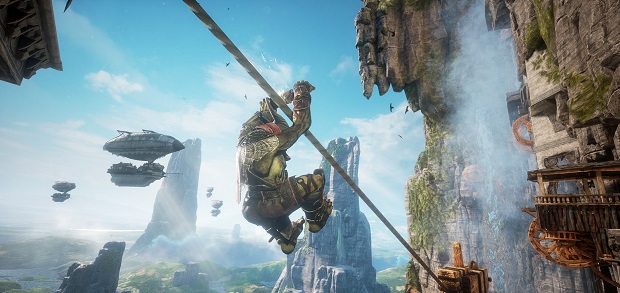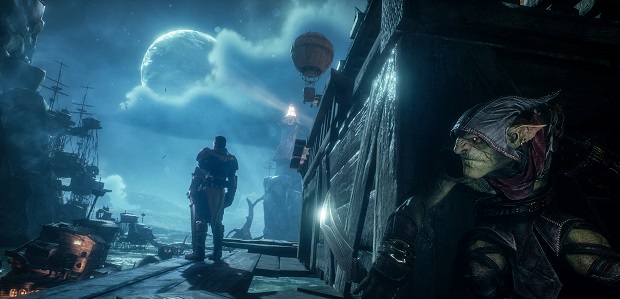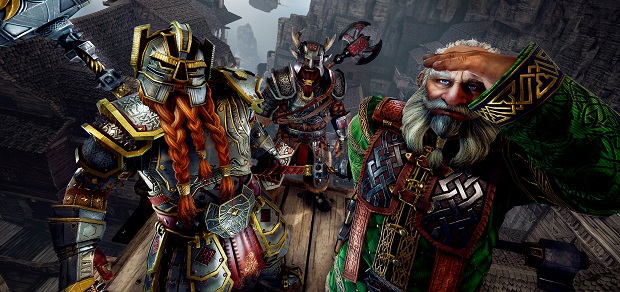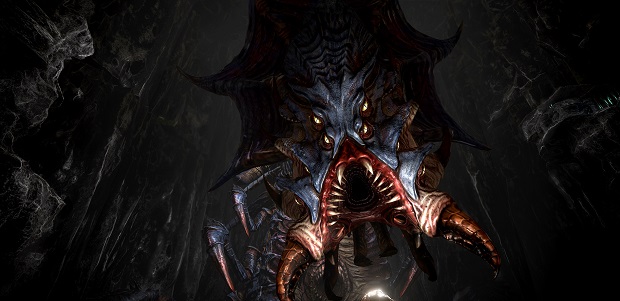Styx: Shards of Darkness is a vomit-y fantasy Hitman
Styx has stones
Styx was a game in need of a little refinement. You wanted to take the little oik and clean his fingernails, boot him into a bathtub, and scrub him down til he shone like an emerald. In his first adventure, the titular goblin (he'd smirk at being called titular) did some decent stealth, stabbing and scurrying through a handful of levels that were solid if unspectacular. It all worked fairly well but it didn't pack any real surprises.
Pleasingly, the sequel Shards of Darkness [official site] looks like it might deliver a polished version of the original, though some of the rough edges are still noticeable in the opening level I played last week.
Styx is grosser than ever. His cloning ability is present and correct, and involves a ball of mucus that turns into a goblin replica. He can vomit in food and drink to poison guards who take a nibble or a sip. When he dies, he does little fourth wall breaking insults directed at the player, often referencing pop culture (sinking into goo, he switches his Terminator thumbs-up into a different single digit gesture). He's a little git, but he's your little git, and there's a certain pleasure in striking against the just-as-gross humans who act all superior even while they're farting and scratching their arses.
Behind all the silliness, there's a serious stealth game though and it reminds me of Hitman more than anything else. There's a similar farcical element to the improvised escapes and murders that follow detection, and the level design encourages experimentation, even in the smaller confines of the level I played. Stealth games often move slowly, with lots of creeping and clinging to shadows, but Styx spends a lot of time clambering on ledges and using his weird little tools (acid and fungus and those horrid clones) to cause merry chaos. You can sneak and observe, clocking patrols and figuring out how to kill guards and hide their bodies, but the whole game is structured to encourage a playful approach.
You won't unlock every ability on a single playthrough so choices have to be made. Perhaps you wish you could turn invisible from time to time? OK, sure. It feels a bit like cheating, something that the level designer agrees with when I mention it, but that's ok. If people want to play that way, they can, and if people want to play through the entire game ghosting every level, without using abilities, that's possible as well. There's been a very deliberate effort to make the new levels support as many playstyles as possible, which in turn can make the game as difficult as you'd like it to be.
Combat will never be easy though. Styx can parry, with the correct timing, but if more than a single guard is alerted, you're best off ditching your current approach and hiding til everyone calms down. Death comes quickly for a fragile little goblin and even though he's terrifying when striking from the shadows, something that the intro makes clear as guards are picked off in increasingly ridiculous circumstances, Styx is not a fighter. He's not a lover either. He's a nuisance, a pest and a crook, but the ugly little world he lives in needs that kind of bastard to kick back against the pricks.
Even with limited playtime in a level with fairly basic objectives - go there, steal the thing, get back out - I found time to muck around. The clone is a fantastic little device, causing guards to react as if they'd seen Styx, and seeming like nothing more than a decoy or safe way to conduct a trial run at first. But it's deeper than that. With the right upgrades you can use it to not only conduct an experimental infiltration, but can then teleport the real Styx to its position once it has achieved its goal. It's a multitool, allowing you to scout, sabotage and confuse enemies. A stone thrown into Lake Stealth to watch the ripples that it creates.
A later level is based around investigation and assassination. When you start, one of several possible NPCs is selected as your target. To find out who that is, you'll need to gather clues scattered around the area. If that kind of inventive objective is put to work alongside smart level design, this will be the sequel for not only the people who enjoyed the first game, but for the people who skipped it because it didn't look like it had enough of a hook.
The introductory level that I have played is fine, though its shanty town is sometimes a little difficult to read. Locating ledges that Styx can grip and clamber up isn't as easy as I'd like, though it'd be simple enough to learn the tells of the textures. Jumping is a bit janky too, leading to a couple of deaths that didn't feel justified. There's a difficult balance between the kind of freedom the developers are trying to give players and the tight controls that avoid accidental death or discovery, and I don't think Styx is hitting the sweet spot just yet (he'd smirk at that phrasing too).
I'd gladly play more though, right now if I could. The level design will make or break it, because Styx himself has enough tricks to be the sort of swiss army goblin character that this sort of stealth game needs. Fiddle with him and you'll find the right tool for almost any situation (yep, sorry), but he needs the right kind of areas to use them in.
Earlier today, Graham wrote about the original Styx:
"If you've played every Thief game, Dishonoreds 1 and 2, and all the other classic and bigger budget stealth games, Styx might briefly sate your appetite. It's not a great game or an inventive one, but it's pleasant. Here's hoping the sequel due this year is a little more ambitious."
Hope springs eternal, vomiting poison along the way.
Styx: Shards of Darkness is out in March.




